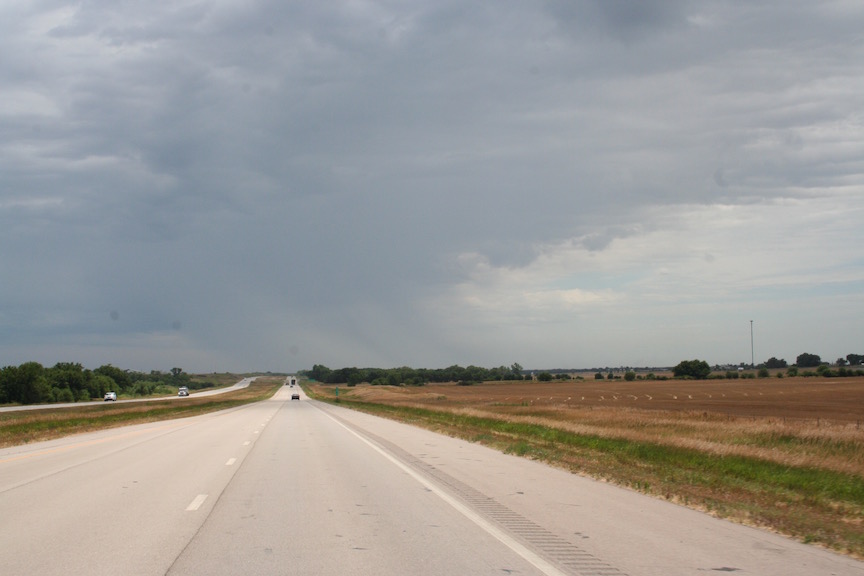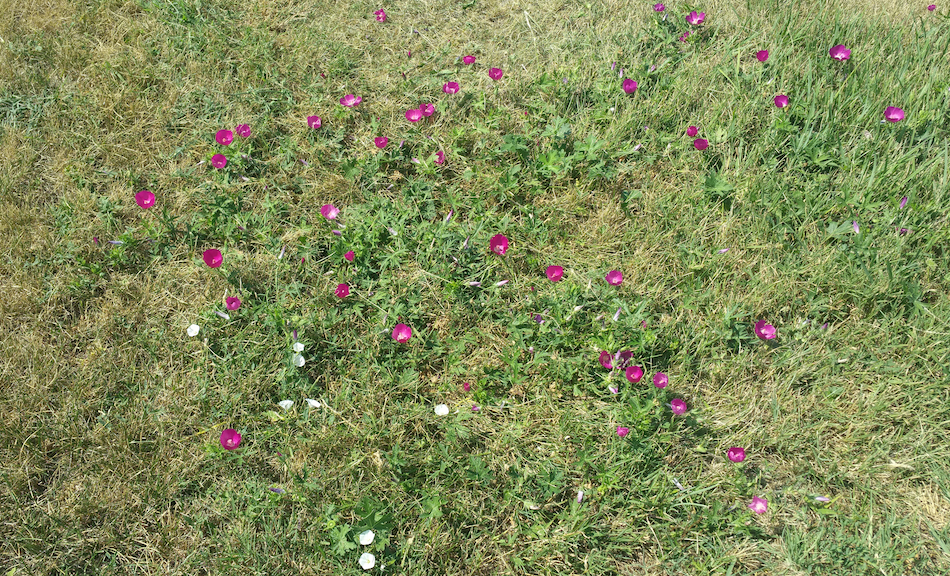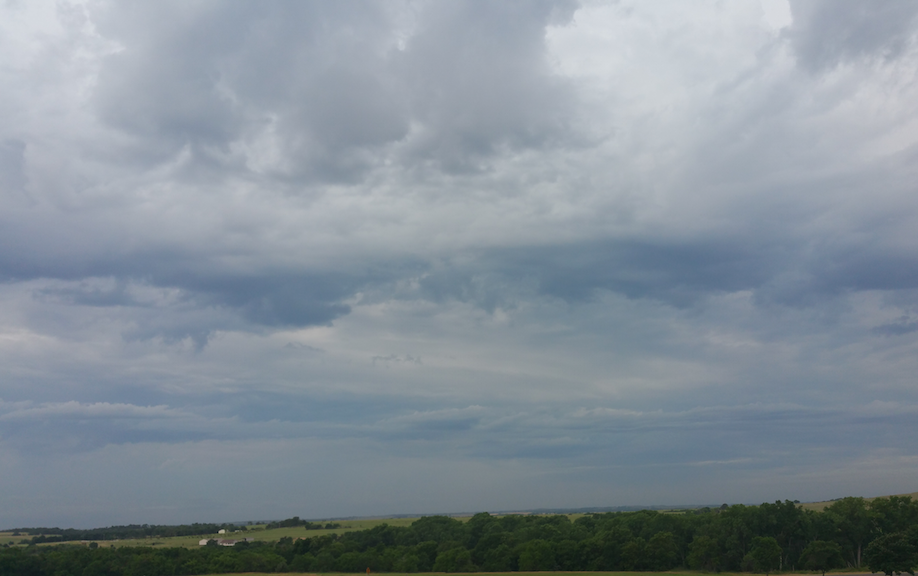This past week I drove to Nebraska and back. It’s beautiful country. I had never been there before, but I will certainly go there again.
 I left Wednesday morning. I drove as far as Salina, Kansas (I had never been to Kansas either), where I stopped for a couple of nights. I planned it that way – though I did not plan it very well. I thought that in the bland solitude of a Salina hotel room I would be able to finish a writing assignment that is hanging over my head. But while it was helpful to get away from some of the demands and distractions of life here in Lone Star suburbia, I couldn’t get away from the things that are really getting in the way of my writing. Those I carry with me – we all do. I did make some progress on the draft, but it’s not enough. Because, right now anyhow, I’m not enough.
I left Wednesday morning. I drove as far as Salina, Kansas (I had never been to Kansas either), where I stopped for a couple of nights. I planned it that way – though I did not plan it very well. I thought that in the bland solitude of a Salina hotel room I would be able to finish a writing assignment that is hanging over my head. But while it was helpful to get away from some of the demands and distractions of life here in Lone Star suburbia, I couldn’t get away from the things that are really getting in the way of my writing. Those I carry with me – we all do. I did make some progress on the draft, but it’s not enough. Because, right now anyhow, I’m not enough.
On Friday morning I left Salina and headed due north on Highway 81, through the rolling hills of northern Kansas and into the rolling hills of southern Nebraska. I crossed the Little Blue River near Hebron, and some time after that I turned off on a highway, and then on numbered roads, as my GPS directed me. After two hours of driving I arrived at the tiny farm town where my grandmother was born, and where she went to school, and about which she spoke with such fondness and love all her life.
 My first stop was the cemetery, to find the graves of my great-grandparents and my great-great grandfather. It is not a large cemetery, and I found the family patriarch’s grave without much trouble. He was a Union veteran, like so many of the town’s founding settlers, and he had a large headstone with an accompanying bronze marker placed there decades ago by the Daughters of the Grand Army of the Republic.
My first stop was the cemetery, to find the graves of my great-grandparents and my great-great grandfather. It is not a large cemetery, and I found the family patriarch’s grave without much trouble. He was a Union veteran, like so many of the town’s founding settlers, and he had a large headstone with an accompanying bronze marker placed there decades ago by the Daughters of the Grand Army of the Republic.
My great-grandparents’ graves were a bit harder to find. I might have wandered a good while in the sun if I had not flagged down a township maintenance truck that was trundling slowly past. I asked the driver if there was a directory of the graves, and he pointed me to a kiosk standing outside the fence of the cemetery on a different side than I had come in. There’s a little plywood box with a latched lid, and if you lift the lid, there’s a binder in there, with a simple schematic map of the plot arrangement and then a listing, by name, of the burials, with the plot number, row number, and grave number for each.
So I found their names, and then I found their graves, in the southeastern corner of the cemetery. There they lay, side by side, with simple headstones hewn from red granite; the engraved surface was squared and polished smooth, but the sides were rough. I don’t know when anybody last visited their graves. My grandmother was their youngest child – the youngest of nine – and she outlived all her brothers and sisters and many of her nieces and nephews too. And out of that big, boisterous farming family she was born into, eight of those nine siblings moved to California during the Depression and after World War II. So maybe the old folks – Mother and Dad, all their children always called them with warm affection – have rested in quiet as well as in peace.
Of course I didn’t think to bring flowers with me. But if I had brought any, I would not have left them. For there were wild prairie flowers growing right up through the cemetery grass. Callirhoe involucrata is their Linnaean name, though they are known locally as “purple poppy mallows” or – sweetly – “winecups.” There they grew, low to the ground, their bright open faces turned guilelessly to the sky. Cut flowers would have been a garish imposition. 
After wandering through the cemetery for a while longer, I got back in my car and headed up the numbered road and into the town.
It’s a sweet little town. Certainly it has never been very populous, though it was a vibrant and sociable place in my grandmother’s recollection. But like so many small farm communities in the Midwest, people are moving nearer to larger population centers to find work, and the town is slowly fading away. There is a gas station, and a small general store (it’s either a gun shop that sells groceries or a grocery store that sells guns) and one or two other businesses – a farm equipment servicing business, an insurance agency, a little home-made gift and craft store. But there is not a diner, or a coffee shop, and of course no school any more. But the people in the gun/grocery store were nice, and the owners of the gift shop were lovely, and the town maintenance worker who helped me find my way in the cemetery was kind.
So I bought a t-shirt from the general store and some homemade candles from the little gift shop, and I walked around the town and took a few pictures, and I wished very much that I knew which of the little frame houses might have been the one my grandmother lived in as a girl, after her father lost his farm and before her mother died, and before she graduated from the town school (all twelve grades in one brick building long since torn down), and went to live with her oldest sister, and worked to put herself through nursing school. But I didn’t know which house had been theirs, which house had been hers. So I got in my car around noon and drove all day, all the way back to Texas — all the way back to my house, if not exactly all the way home.

2 Thoughts on this Post
S-USIH Comment Policy
We ask that those who participate in the discussions generated in the Comments section do so with the same decorum as they would in any other academic setting or context. Since the USIH bloggers write under our real names, we would prefer that our commenters also identify themselves by their real name. As our primary goal is to stimulate and engage in fruitful and productive discussion, ad hominem attacks (personal or professional), unnecessary insults, and/or mean-spiritedness have no place in the USIH Blog’s Comments section. Therefore, we reserve the right to remove any comments that contain any of the above and/or are not intended to further the discussion of the topic of the post. We welcome suggestions for corrections to any of our posts. As the official blog of the Society of US Intellectual History, we hope to foster a diverse community of scholars and readers who engage with one another in discussions of US intellectual history, broadly understood.
A tribute to you: Bruce Springsteen, “Reason to Believe”— from the Nebraska album. – TL
Thanks, Tim. Have actually never listened to that song (or that album) before. Will have to check it out.
I drove with the radio (or the iPod) on for much of the trip (also drove with the top down for all but the very hottest hours of each day, so despite not heading for a beach, I got plenty of sun), but when I left the highway started driving the backcountry roads in Nebraska, I turned off the music and listened to sounds of summer in the farmland. There was such a profusion of song birds — larks, redwing blackbirds, some other birds I can’t name and whose songs were new to me (maybe whippoorwills? my grandmother mentioned hearing them often when she was growing up) — that their sweet calls came through clearly over the normal background noise of the open road. It was really something.